
12 minute read
INFLATE | PROTECT Cover Story
INFLATE | PROTECT Cover Story
DEFLATE | STORE
Advertisement

Many of us use devices that are fragile and susceptible to damage or breakage. Care must be taken to prevent damage to such a device – especially when the user relies on the device for his or her occupation, adventure and, at times, even to protect the user’s life. This potential exists, for instance, when a device is carried or otherwise transported in the austere environments where we work or play. An exemplary device that includes fragile elements that are susceptible to breakage is a modern, aviator flight helmet.
In the early 1900s through the end of WWII, the aviator’s helmet was made of soft leather and intended mainly to protect from wind and cold. As advances in wireless radio communication developed, the leather helmet began to feature earphones for radio receivers. Later, as turbocharging technology permitted higher aircraft operating altitudes, the oxygen mask attachment became standard as well.
Early eye protection in the form of rubber-framed glass goggles were adopted from the fledgling days of manned flight as the most reasonable way to protect the eyes--especially in open-cockpit machines. As operating speeds became substantially increased with the advent of jet aircraft, rigid visors were developed as part of the helmet to protect aircrew from the deadly windblast effects of emergency ejection.
Over the years, the flight helmet has served first and foremost to protect the pilot’s head in various situations: from bumps and scrapes on the flight line or in the cockpit, to the dangerous environment of an aircraft carrier deck, and more critical still in the case of high-speed ejection. Like any piece of equipment however, man has found a way to make this device even more
useful, combining functionality and advantage with the basic requirement of safety. But if we simply look at the period up until just a few years ago of the flight helmet’s life, it seems to have stagnated technologically and thus, strayed little from its primary goal of protecting the pilot’s head. Over this period most modern helmets have offered the following similar capabilities: protective outer shell, comfortable interior, attached visor, radio communication, source of oxygen, and add-ons like an attachment for a separate Night Vision Device (NVD). Although convenient and useful, few, if any, of these capabilities are absolutely critical to fly and employ the aircraft. This has changed for the 4th and 5th generation of aircraft and resulted in a growth in the importance of the flight helmet as a source of combat advantage outside its basic protection role. In the latter stages of 4th generation aircraft maturity, on platforms such as the F-15, F-16, F/A-18, F-22 and various foreign competitors, the development of a helmet mounted cueing system has changed the direction of flight helmet requirements and has begun a shift in the definition of its primary function. In a sense, tactical employment of the helmet’s cuing system and the advantage gained by its use, have changed the focus of both construction and the role the helmet plays. Add to this the ability to see the video of an aircraft sensor (like IR Imagery) displayed on the visor, and the utility of the helmet increases dramatically. Both of these capabilities are available now on helmets such as the Joint Helmet Mounted Cueing System (JHMCS).
The helmet used on the F-35 Joint Strike Fighter has all of these capabilities and more. In fact, the F-35 no longer uses the Heads-Up Display (HUD) that has become the standard in modern tactical jets. The critical information previously displayed on the HUD will now be contained in the
helmet. The pilot is able to access the information required to fly the aircraft almost regardless of where he is looking. This critical flight information will only be available in the helmet he wears, making it indispensable flight equipment. In addition, he will be able to use NVDs and various infrared cameras and display options, DAS (Distributed Aperture System), etc. without taking any additional gear to the aircraft, like is the norm at present. All of these options are contained within the flight helmet he carries to the jet. The trade-off is that this new helmet has become a very sensitive and fragile piece of gear – more so than any other piece of gear he uses. Where the helmet once served merely to protect the pilot’s head, the pilot will now, in some capacity, serve to protect this helmet!
Gone are the days of careless handling and use of a fighter aircraft helmet. The pilot who now relies on this helmet to successfully fly and employ his aircraft will be acutely aware and concerned about the safety of this helmet while in transit to and from the aircraft as well as any other time he is not using it for flight.
It serves to reason that, like all technology, these improvements come at a price. What the pilot might have considered expensive for the previous helmet he wore will pale in comparison to the price tag on this new helmet – to an order of great magnitude ($500K USD for F-35 HMD). So, another factor contributing to the critical nature of helmet protection is its extremely high price relative to past years and former helmet bag solutions – a fact that will be realized by both the end user and the numerous individuals and services responsible for acquisition and maintenance of these helmets. What is required is something to aid the pilot and technician in a mounting challenge to protect this helmet.

The F-35 is the only aircraft that has ever had the helmet made in conjunction with the aircraft.

Designed to give F-35 pilots unprecedented situational awareness by displaying airspeed, altitude, targeting information, and threat warnings on the helmet’s visor.

The helmet component connects to the Distributed Aperture System (DAS) system which gives pilots a God’s-eye view of the battlespace.
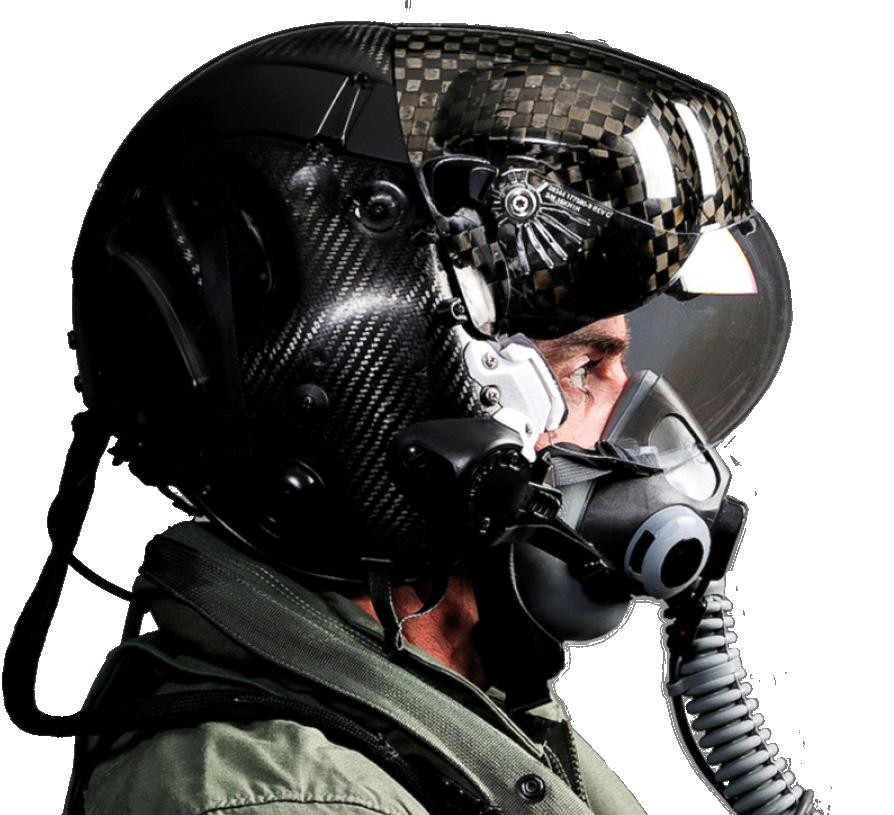
F-35 HMD is a sophisticated and sensitive helmet system offering the pilot a wealth of information for both navigation and tactical execution, all transmitted to the visor and accessible regardless of where the pilot is looking.
Providing a Solution
Air Armor Tech provides the solution. Until now, the pilot or aircrew technician had to make a tough decision concerning the tradeoff between protection and collapsibility. In the modern fighter aircraft, space in the cockpit is extremely limited. The choice: • A hard, plastic case that is fairly protective, but will not fit in the aircraft • A standard, quilt and nylon bag that is collapsible but not protective from anything more than scratch – i.e. it does not protect from shock damage
But Air Armor Tech has a solution that does both jobs better – with AIR! Blaine “Rock” Tompkins served 11 years in the USN flying F/A-18 Hornets and Super Hornets and another 10 years in the USAF flying F-16s. His JHMCS in the Super Hornet cost $200K USD and in the Scorpion in the Viper cost $150K USD. While working on the F-35 program as a Pilot SME, he found the astronomical $500K USD cost of the HMD to be very concerning and knew how the average pilot treated equipment – usually without great care. So how do you protect a $500K helmet? With the above limitations in mind he knew there had to be a better way. Then he remembered he already wore an inflatable G-suit and an LPU (Life Preserving Unit) – both of which inflate to
The AAT helmet bag provides extraordinary 360 degree protection in a light-weight, collapsible method never before available on the flight line, ship or shop setting.”

protect the user and then deflate to store at a more compact size. Why not just create a bag with an inflatable bladder that accomplished the same goal. Air Armor Tech was born on this revolutionary concept and has been issued US Patent #9,999,272. The Air Armor Tech (AAT) Helmet Bag The AAT Helmet bag provides an aviator helmet, especially 4th and 5th Gen with 360 degrees of extremely durable, airfilled protection as it conforms to the helmet. Drops from even considerable heights are no longer a threat, much less minor bumps and scrapes that occur regularly. It is light weight and
can be deflated for compact storage when not in use (i.e. cockpit, shop, shipborne storage, shipping, etc.). All of this affords pilots and maintainers the peace of mind that their expensive, sensitive and critical equipment will be protected against all unfortunate but inevitable scenarios, reducing repair/replacement costs and, possibly more important at times, safeguarding readiness and sortie execution.
Though originally designed for the F35 HMD the AHB will accommodate a myriad of other Helmet systems to include: Scorpion, JHMCS, ANVIS/HUD, IHADSS, Jedeye, etc. Weighing in at only 4 pounds, it can be inflated in ~4 breaths and, when deflated, it will roll up into a 10- inch x 4-inch diameter roll or folded to fit in


the cockpit or save space in a ship or shop space. Some of the premium features that can be found on the case are: • Rugged 1000 Denier Ballistic Nylon outer shell • Water, Dust and Impact Resistant • Puncture resistant, mil-spec, RF welded and urethane-coated bladder • Integrated padded carrying handle and shoulder strap with reinforced stitching • Can be used as a protective shipping device • Inflation method: • Oral – Halkey Roberts Oral inflation Valve (same as found on LPU) • Mechanical • Shop Compressor with rubber conical tip • Needle – any pump that can accommodate the same needle used on inflatable sports balls • Over-inflation valve – up to 5.35 psi, +/- 10% • To guard against over-inflation due to temperature, altitude or incorrect mechanical inflation.

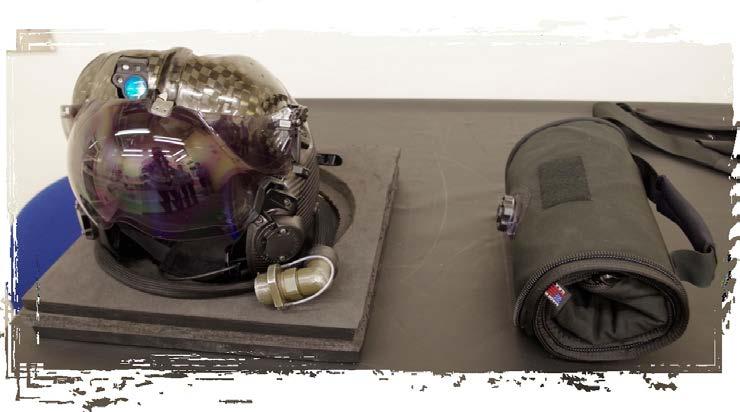
In essence, the revolutionary technology that AAT offers will provide extreme protection in a light-weight, collapsible form never thought possible on the flight line, shop or ship-borne ops. It will protect a highly valuable, critical piece of flight gear, increasing readiness, decreasing space requirements and ultimately saving the taxpayer a great deal of money. Other Military and Civilian Products by AAT Air Armor Tech currently sells Aviation Each F-35 HMD form fitted to each pilot and difficult to quickly exchange or fix when damage occurs.
AAT HB unzips for storage, maintenance, inspection
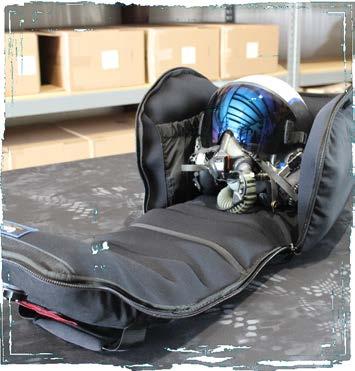
Blaine “Rock” Tompkins is a fighter pilot with 3,000 flight hours, 20 years of service and multiple combat deployments with both the US Navy and US Air Force in the F/A-18 Hornet and F-16 Viper. Asked in 2009 to work on the newest fighter aircraft, the F-35 Lightning II, which incorporates advanced avionics,
Deflated AAT helmet bag next to the new F-35 HMD
sensors and weapon systems into a pilot helmet, he immediately recognized a looming problem that would need to be solved… While the $500,000 helmet performed well, the increased sensitivity, value and requirement to fly the jet could not be adequately protected by the standard issue quilt lined bag that did little more than provide a means
of carrying the helmet. Hard case options are simply too heavy, bulky and do not fit into the cockpit. Perhaps being both protective and collapsible was seen as an impossible option, but it got “Rock” to thinking – Why couldn’t one devise a case that offered the needed protection but took up less space? So, he did… with AIR!
Air Armor Tech’s inflatable gun case being run over by a HumVee – now that’s tough protection!
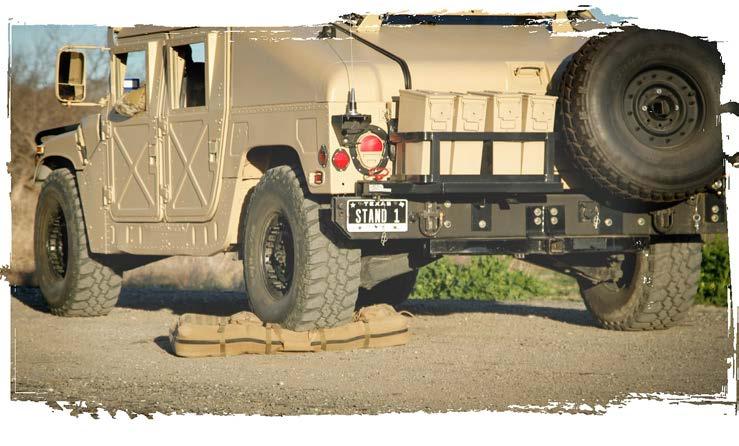
Helmet Bags, Rifle Scope Covers and Gun Cases. However, there are dozens of Inflatable Protective products on the books that include: Gun Sleeves, Archery, Camera, Camera Lens, Drone, Critical Radio and Digital Equipment, Shipping Containers, FLIR/NVG Cases, etc. – essentially, any piece of critical equipment, especially when used in
austere environments, that needs to be protective, light-weight and eventually collapsible for storage.
Blaine “Rock” Tompkins Air Armor Tech www.airarmortech.com + 1 817.487.3837 Australian Dealer: https://www.aeropartsaustralia.com.au Photo credits Lockheed Martin

Ultimate defence with robust and reliable medium voltage solutions
Ensure a reliable end-to-end solutions provider for your defence requirements, NHP o ers an extensive range of medium voltage solutions, allowing application exibility as well as higher productivity and safety.
From quality medium voltage switchgear to longlasting transformers and market leading substation and automation solutions, the NHP medium voltage range can be customised to suit your speci c performance criteria and are reliable, robust and built to last.
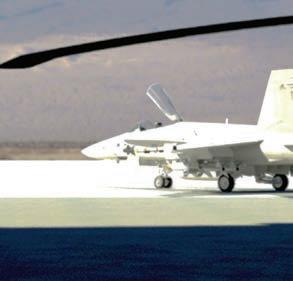
When it comes to medium voltage, trust NHP to engineer a customised solution to help you gain a competitive edge.
NHP ELECTRICAL ENGINEERING PRODUCTS 1300 NHP NHP | nhp.com.au |

Blaine “Rock” Tompkins






